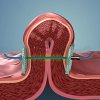.jpg)
Traditional bariatric surgery for weight loss has benefited thousands of people, but many who are interested in it are concerned about the incisions and some of the potential side effects involved. USGI Medical out of San Clemente, CA is finishing up enrollment in a U.S. study of its g-Cath EZ Delivery Catheter with Snowshoe Suture Anchors that allows for incisionless endoscopic bariatric surgery through the mouth.
With the catheter, surgeons can fold stomach tissue and place anchors across the folds, reducing the stomach volume. The company enrolled 332 patients at 11 hospitals across the country that will receive either the g-Cath or sham treatment, and everyone will be followed for at least two years afterwards. Of note, all of the devices that make up the company’s Incisionless Operating Platform are already cleared in the U.S. and Europe.
Some details about the technology from the product page:
The g-Cath™ is an integral accessory to the g-Prox® tissue approximation system. The catheter ends in a hollow needle and contains a pair of Snowshoe Suture Anchors™. A sliding button on the g-Cath allows the surgeon to advance the tissue anchors and deliver them on either side of a tissue fold or apposition. Then, the operator uses the g-Cath to bring the two anchors together with adjustable tensioning. The cinching is user-controlled under direct vision with tactile feedback, similar to a traditional suture. Also, the tension flattens out the mesh anchors, securing the tissue.
The Snowshoe Suture Anchors are a suturing technology designed to overcome the challenges of endolumenal suturing in the GI tract. It is well known that mucosa is resistant to reconfiguration and the forces applied by traditional “point loading” suture, staples, clips, or T-tags can often result in inadequate healing. However, a Snowshoe Suture Anchor distributes the forces over a tissue contact “footprint” 2,400% larger than the size in which it was delivered. Furthermore, the anchors not only spread out these forces, they also have a semi-compliant nature that accommodates postoperative swelling. This plasticity allows the anchors to withstand the swelling, yet maintain their hold on the tissue.
Source:USGI Medical
USGI’s New Incisionless Endolumenal Bariatric Surgery Technology

